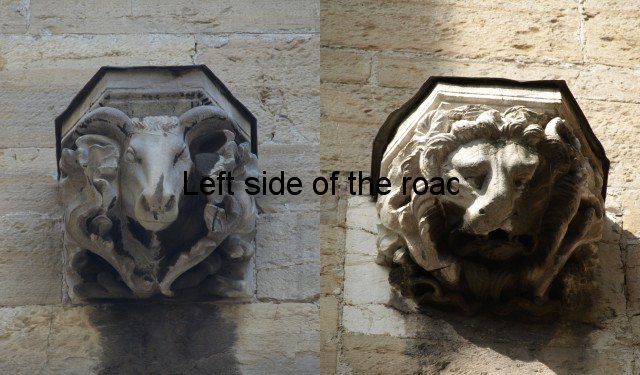The Eccentric, Unusual and Bizarre in Bergamo
When people arrive in a tourist destination they often have a list of those highlights they wish to tick off – the ‘been there, done that, bought the T-shirt’ sort of idea. Whilst, in general, there’s nothing wrong with that approach it tends to mean that tourists race around (or are taken around) the major sites and in the process miss out on what makes the place ‘human’, somewhere people have lived for generations. Here I hope to give an introduction to the eccentric, unusual and bizarre in Bergamo.
There’s a widespread misconception that cities and towns in the medieval period were drab places to live and that everything was without colour. We know from paintings of the era that the rich and powerful lived a sumptuous life, in both their clothing and the way they decorated their palaces, but it’s becoming more widely accepted that the lives of the workers and peasants weren’t totally devoid of the occasional splash of colour.
Yes their homes were hovels and their clothes were rough and (hopefully) functional without a great deal of adornment. This mirrored their lives which was generally ‘nasty, brutish and short’. However, in public places they too could appreciate an escape from the drabness of their existence.
Those who visit Bergamo and enter some of the many churches can understand the colourful experience that ‘going to church’ offered even the most meek in society. This exposure to art and culture didn’t start with the Renaissance but goes back at least 1300 years as the walls of the Romanesque gem in Bergamo, the church of San Michele al Pozzo Bianco, testifies. These frescoes date back to the year 700, more or less, and were being updated for the next 700.
But how many of those who make the effort to down the hill from the funicular station look up to the left of the entrance to make out the faded frescoes on the outside of the building. The entrance has undergone many changes and it’s certain that some of the frescoes have been lost forever. The ones that still exist are gradually fading and becoming very indistinct but they do provide a clue to how the town would have looked in its medieval heyday.
Although many are suffering the ravages of time and lack of maintenance there are still exterior frescoes in a number of locations in the Città Alta, all you have to do is look up. Leaving Piazza Mercato delle Scarpe and going along Via Gombito towards the Piazza Vecchia, high up on the right are scenes depicting the buildings and canals of Venice, demonstrating the connection between the two cities. There are also remains of such wall paintings in the Piazza Mascheroni and the Piazza Cittadella.
Also worth looking for are the tromp d’oeil (those paintings that give an illusion of reality). In Bergamo these are often false windows or pilasters, architectural devices that make the building grander than it really is, as well as being a bit of a joke. Many hundreds of thousands of people walking through the streets of Città Alta have seen them but how many knew what they were seeing? Remember it’s the illusion of reality and by concentrating you are able to break down that illusion and determine what is, and what is not, real. There’s also a fine interior example of a false window above the main door of the Cathedral.
As you’re walking around notice that the general façades of the buildings are much more colourful than they are in the likes of the UK. There’s no excuse to say that Italy is a Mediterranean country as Bergamo is in the foothills of the Orobie Alps. We are now starting to realise that in Britain even the Cathedrals were multi-coloured on the outside more than 500 years ago – we just seem to have lost that desire for colour in our everyday life.
As you walk around look out for the clocks – both mechanical and non-mechanical. In the small square of Piazza Angelini you have a fine example of a sun-dial on the side of a building stretching to four or five stories high, this is known as the Greek Clock. Another sun-dial can be found in the Piazzetta Duomo. The ‘mechanism’ is on the ground under the Palazzo della Ragione, white stone amongst the grey. But it’s all dependent on the light coming through a hole in a metal plate with a ‘sun face’ which is attached to the top of the arch above. You get a good view of this plate from the steps of the Cathedral/Duomo.
Clocks which are easier to read are also to be found in a number of places. The most obvious is that which on the tower of the Campanella, the gateway between the Piazzas Mascheroni and Cittadella. Another, this quite ‘hidden’ is one that’s in the inner courtyard in front of the entrance to the Museo Donezettiano in Via Arena.
Going on to faces of a different kind there’s an interesting carving on a keystone over an arch of Casa Lunga, which is just up hill from the Gombito Tower (where you find the Tourist Information Office) and close to one of the public wash-houses. This carving is from the 11th century and represents San Vincenzo (Saint Vincent).
Another charming, and I’m sure often missed, ancient carving of a face can be found on the outside of the central apse of the Basilica of Santa Maria Maggiore (that’s the other side of the main altar). This is said to be the image of designer (why not architect, I don’t know) and Master Builder Fredo, who began the building in 1132.
A couple of other faces, this time of animals, are also found close by on the walls of the Santa Maria Maggiore and these are of the Lion (the symbol of Saint Mark – and again another reference to Venice where he is the Patron Saint) and the Bull (the symbol of Saint Luke). I looked for, but didn’t find, the symbols of the other two evangelists, Matthew (an angel) and John (an eagle) but couldn’t find them. It’s possible that they were on that part of the wall that was destroyed when the local gangster caused the Colleoni Chapel to be built in place of the Sacristy in the 15th century.
What I did find, in this same part of the building, was the plaque that tells you that Bergamo’s Città Alta is 369.38 metres above sea level at high tide on the Adriatic. This is a little faded and why it was of any great interest when it was placed there I don’t know how many years ago is a little bit of a mystery to me. From my time travelling around Spain I know that such plaques exist in at least one location in virtually any place of any size but haven’t come across quite the same situation in Italy.
I’ve been in hundreds of churches of all shapes and sizes in the past and after a very short while the Crucifixion and the Nativity start to become much of a muchness. To keep the interest going I always search for something different. In Bergamo the gem of the unusual (and the bizarre) are the macabre paintings behind the altar of the Santa Grata Inter Vites. However, other churches offer up items of interest.
In the Santa Maria Maggiore you can find (to the right as you enter the building from the South Portal) a painting of the Last Supper. What I like about this one is the young serving boy who is looking over Judas’s shoulder at the bag containing the 30 pieces of silver. Also in this basilica is the modern statue of a very gaunt, kneeling Christ.
In the church of Santa Agata del Carmine it’s worth looking for the skull relics, in a chapel on the left hand side as you walk towards the altar, as well as a painting on the ceiling of a young Christ carrying a large piece of wood into his father’s carpentry workshop, presaging his walk to Golgotha. The Crucifix is literally hanging from the pillars and to the right of the altar is a painting of Santa Apollonia having her tongue pulled out as part of her martyrdom.
I always look out for Last Supper paintings to find out what was on the table, this was after seeing an impossibly huge guinea pig presented for the meal in the Cathedral in Cuzco. If what’s up for grabs isn’t different the depiction often is and I like the pig that’s on the table in a fresco in the Aula Picta (attached to the western side of the Santa Maria Maggiore) which has its four legs just sticking up in the air – painted at a time when perspective had yet to be re-learnt. Also on the walls here is a somewhat aggressive looking Christ with a sword in his teeth – a little unusual.
I could go on in much more detail but I’ll just list a few other things to look for: the carvings at the top of the old capitals throughout the town; the face corbels holding up the roof over the steps leading up to the entrance of the Palazzo della Ragione; the modern painting on the side of a house in Via Tassis: a studded door in the same street; the pump to get water for the fish market from the ancient cistern of the 14th century Fontanone Fretto; plaques of the original basilica (San Alessandro) that was outside the city walls, at the top of what is now Via Borgo Canale; as well as ornate door knockers and pillars on the doors of the houses of the rich and niches with Madonnas and street corner shrines. That doesn’t cover it all and I’m sure there’s much I’ve missed or yet to find.
Once you’ve done the main attractions just take some time to walk slowly around the town, eyes directed a little upwards and you’ll be rewarded with a better understanding of the history of the place through noticing the eccentric, unusual and bizarre in Bergamo.











